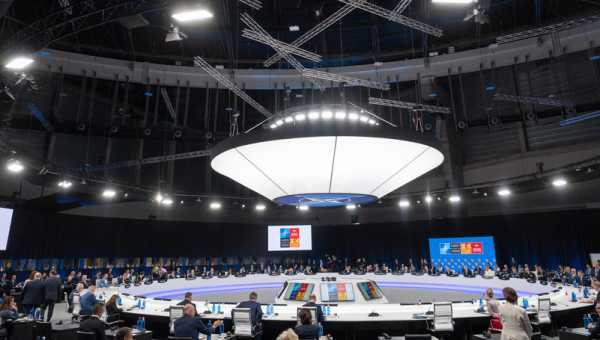
An internal procedural flaw, voting unanimously, remains one of the Kremlin's dwindling advantages to divide Nato (Photo: Nato)
The summer heat in Spain can be a killer if you are not careful.
For Nato’s Madrid summit, the scorching temperature wasn’t the only the challenge they had to contend with.
An inexhaustible litany of security factors truly made this summit unprecedented in the alliance’s 70-plus years of existence.
With a hot war raging on the continent and the prospect of expansionist aggression from Russia against allies to an accelerating global energy and food crisis, as well as worsening climate disasters, there was no shortfall of topics for the new Strategic Concept to address.
Against this backdrop, for the most part Nato and its 30 leaders rose to the occasion, but it wasn’t without room for improvement.
Russia justifiably preoccupied policymakers where no chance was taken vis-a-vis president Vladimir Putin’s irredentism. Nato took a massive step in re-establishing a credible deterrence posture on its Eastern flank, shifting from enhanced forward presence to enhanced forward defence.
Although the sheer number of new soldiers and newly prepositioned equipment is a welcomed development, for this measure to have the maximum effect Nato soldiers will need time be localised in their new surroundings to execute like resident soldiers. Drafting an entire new team to work well together in a new setting doesn’t happen overnight.
View from Beijing
The serious reinforcements sent to Nato’s most exposed allies can be read by China in two ways. A positive interpretation would suggest that the west is again too concentrated on Europe and deprioritising Asia, while a negative assessment would deduce when allies are threatened, they are seriously backed, and treaty commitments are holy.
Staying on the continent, all the broad language brushstrokes supporting Ukraine were pitch perfect. There is every reason to believe that the Nato-Ukraine Contact Group will exist as long as necessary to support Kyiv.
Despite this, the Madrid Declaration failed to mention the word victory for Ukraine which leaves concern that not all Allies are working towards the same goal — Russia’s total defeat on the battlefield.
Nato is not the answer to breaking Russia’s maritime blockade. Those most victimised by the blockade remain outside of the West so the threat is none existential diminishing the risk-reward paradigm to assume leadership on this.
Putin’s ‘slow attrition’
Ukraine conflict fatigue is real and a legitimate advantage for Putin to grind out his policy objectives. He is married to this strategy of slow attrition and wants to push the conflict as long as possible, maybe like Korea, to stretch his hollowing forces and wear down public support.
As economic conditions worsen, Nato capitals must take a hands-on approach to engaging with citizens paying higher prices and make the case that its all of us versus Russia, no just Ukraine. Failure to do so risks a political contagion emerging.
Undoubtedly Sweden and Finland joining Nato is an epic watershed moment considering their historic military non-alignment.
Nevertheless, the uncomfortable truth is this process was much harder than it should have been because of president Recep Tayyip Erdoğan domestic instrumentalisation of the situation. Today it was Sweden and Finland’s ascension, tomorrow it will be something else, maybe when time is not a luxury for the alliance.
The lesson remains that Nato still doesn’t know how or want to hold Allies accountable for disruptive behaviour. An internal procedural flaw, voting unanimously, remains one of the Kremlin’s dwindling advantages to divide Nato internally that is still reliable and ever present.
Given the stated goal to better structure the civilian and military sectors in the cyber realm, Nato is ambitiously striving to reach a level where deterrence, and response, in the cyber realm is on par with the physical word.
Of course, the case-by-case basis on attacks is prudent, but scheming with the private sector heavyweights to devise and unleash surgical offensive attacks shows major progress in a complicated field.
‘Green’ Nato?
Where Nato really excelled was preparing itself for the future havoc derived from climate change. Jens Stoltenberg has championed this topic and his legacy as the green secretary general is being written in front of our eyes.
The establishment of alliance wide emission targets, to cut emissions by at least 45 percent by 2030 and reach net-zero emissions by 2050, is titanic and could be argued as the most consequential outcome of the summit. When you dig in, what stands out is that Nato is not satisfied with reducing its carbon footprint, but that it evaluates new green tech as the best tech and holds the potential to be game changing against adversaries.
This progress will only full mature after some time where allies will need to take the long view. Some equipment areas are comparatively more developed than others, like the electrification of the auto industry, where other solutions like synthetic fuels might prove to better fit for heavier equipment than their electrification.
The race for winning green technologies is will underway in the private sector where this news will only push competitors to generate breakthroughs faster. Aligning national systems to ensure all 30 members are on the same page and reading from the same playbook will be the immediate priority at Nato HQ.
With the countdown to the next summit activated, the alliance can ride this hot start from Madrid to ensure total victory in a year’s time in Vilnius. As the heat rises so too will the Alliance’s defences, there is no other choice.
Source: euobserver.com



